AC power plugs and sockets
| Relevant topics on |
| Electrical installations |
|---|
| Wiring practice by region or country |
| Regulation of electrical installations |
| Cabling and accessories |
| Switching and protection devices |
AC power plugs and sockets allow electric equipment to be connected to the primary alternating current (AC) power supply in buildings and at other sites. Electrical plugs and sockets differ from one another in voltage and current rating, shape, size, and connector type. Different systems of plugs and sockets have been standardized, and different standards are used in different parts of the world.
Plugs and sockets for portable appliances became available in the 1880s, to replace connections to light sockets (often in ceiling fixtures) with lower, wall-mounted outlets. A proliferation of types developed for both convenience and protection from electric shock. Today there are about 20 types in common use around the world, and many obsolete socket types are found in older buildings. Coordination of technical standards has allowed some types of plug to be used across large regions to facilitate trade in electrical appliances, and for the convenience of travellers and consumers of imported electrical goods. Some multi-standard sockets allow use of several types of plug; improvised or unapproved adaptors between incompatible sockets and plugs may not provide the full safety and performance of an approved socket–plug combination.
Concepts and terminology


A wall socket or outlet (also known as a power point in the UK,[1] receptacle in the US,[2] general purpose outlet or GPO in Australia and New Zealand,[3] and less commonly plug socket[4] or wall plug[5]) built into the wall of a building, connected to energized electrical wires. Because it has holes it is known as a female connector. Sockets may also appear on portable equipment, such as portable generator, extension cords or power strips, but are still generally the half of the connection that provides the electricity.
A plug (also known as plug top in the UK[6]) generally has matching pins (also known blades or prongs in the US, especially if flat) so it is known as a male connector, and it is connected by a mains cable (power cord) or physically built into a piece of electrical equipment that consumes electricity. Some types of socket have male pins and the matching plugs have female contacts, but for safety reasons these are only used for earthing (grounding in US English). Some plugs have built-in fuses for safety.
To reduce the risk of users accidentally touching energized conductors and thereby experiencing electric shock, plug and socket systems often incorporate safety features in addition to the recessed contacts of the energized socket. These may include plugs with insulated sleeves, recessed sockets, socket apertures with blocking shutters, and sockets designed to accept only compatible plugs inserted in the correct orientation.
A built-in socket may be surrounded by a decorative or protective cover called a wall plate, face plate, outlet cover,[7] socket cover, or wall cover. In some designs this is an integral piece with the socket itself, bought and installed as a single unit.
Electrical sockets for single-phase domestic, commercial and light industrial purposes generally provide either two or three electrical connections to the supply conductors. Two-pin sockets normally provide neutral[8] and line[9] connections, both of which carry current and are defined as live parts.[10][11]
Three-pin sockets add a protective earth[12] connection. This is commonly called simply earth, or in US English, ground. Neutral is usually very near to the same electrical potential as earth, the neutral connection being earthed (connected to earth) either at the building's distribution panel or at the electrical utility's substation. (For further information, see earthing system.)
Line carries the full supply voltage relative to the neutral connection (and also to the earth connection). Line is also known as phase, hot (North America), active (Australasia) and commonly, but technically incorrectly and ambiguously, as live.
Mains-powered appliances that have exposed conductive parts are required by most regulations and standards to use a three-wire mains cord and plug. The earth pin in the plug is connected to the appliance chassis. If the appliance's internal insulation should fail, establishing a conductive path from either line or neutral to exposed metal parts, the connection to earth should ensure that they are held at a low electrical potential. This should protect users from electric shock. If the failed insulation is of low enough resistance, this will also cause fuses or circuit breakers to open, isolating the faulty appliance from the electric supply. In most regulations, double-insulated appliances, meaning those wherein two separate failures of insulation would have to occur before such exposed parts could have any connection to line or neutral, are not required to use a three-wire mains cord or plug.
Depending on the supply system, some sockets may have two line connections, each at a significantly greater voltage compared to earth and without a neutral pin/connection. For example, a split phase system may have 240 V between line connections, each at 120 V with respect to earth. Yet, a single-phase socket connected to a three-phase system may have 208 V between line connections, and 120 V between each line connection and earth.
History
When electricity was first introduced in houses, in the 1880s, it was used primarily for lighting. One common approach for other appliances (such as vacuum cleaners, electric fans, smoothing irons, and curling-tong heaters) was to connect them to light-bulb sockets using lampholder plugs.
As early as 1885 a recognisable two-pin plug and wall socket format was available on the British market. By about 1910 the first three-pin earthed (grounded) plugs appeared. Over time other safety improvements were gradually introduced to the market. The earliest standard on a national scale for plug and wall socket forms was set in 1915.
Application issues
Designs of plugs and sockets have gradually developed to reduce the risk of electric shock and fire. Safety measures include; pin and aperture dimensions, a plug topology that permits only proper insertion of a plug into a socket, earth (ground) pins that make contact before line (power) pins can be connected, and shutters on the socket that only open for a specific plug format. The latter feature prevents foreign objects from contacting live parts of the socket. According to British author John Mellanby,[13] the first shuttered socket was introduced by British manufacturer Crompton, in 1893. Electrical insulation of the pin shanks was added to some designs, to reduce live contact exposure when a plug was partly inserted in a socket; Mellanby shows such a plug from British manufacturer Diamond H, dated 1905. Some types can also include fuses and switches.
Earthing (grounding)
A third contact for a connection to earth is intended to protect against insulation failure of the connected device. Some early unearthed plug and socket types were revised to include an earthing pin or phased out in favour of earthed types.
Different types of plug are used for different IEC appliance classes. The assigned class depends on whether the device is earthed and the degree of insulation it incorporates. Class I, for example, refers to earthed equipment that requires a third contact in the plug and socket, while Class II refers to unearthed equipment protected by double insulation.
Polarization
Where the building wiring system defines a "neutral" conductor that is close to earth potential, it is an advantage for appliance designers to preserve that distinction. For example, appliances may ensure that single-pole switches interrupt the line side of the circuit, or ensure that screw-base lampholder shells are connected to the neutral side of the supply, minimizing the chance of contact with live parts. This requires a plug that can be connected to the socket in only one way, so that the energised and neutral conductors are not interchanged. In most designs, such "polarized" plugs cannot be mated with non-polarized sockets. Wiring systems where both circuit conductors have a significant potential with respect to earth do not benefit from polarized plugs.
Polarization is maintained by the shape, size, or position of plug pins, socket apertures, and socket recesses to ensure that a plug fits only one way into a socket. Lamps with screw bases connect the shell of the lamp socket to the neutral conductor. Similarly, the single-pole switch of the appliance is connected in series with the energized wire. However, because of the uncertainty, in practice, of which conductor is the neutral, some appliances have dual-pole switches, which interrupt both conductors.
Though rotationally asymmetrical, Argentinean connectors have the opposite polarity to those of other Type I countries.
Universal sockets and adapters
"Universal" or "multi-standard" sockets are intended to accommodate plugs of various types and standards. They are sometimes used in China[14] and other Asian countries, such as India,[15] Indonesia,[16] Japan,[17] Singapore,[18] Taiwan,[19] and the Philippines.[20] In some countries, and other jurisdictions, they violate electrical (safety) standards that apply to portable sockets (such as power strips) or fixed sockets (wall outlets). This includes Singapore,[21] Sri Lanka,[22] the European Union, and Switzerland.[23]
Safety advocates, the United States Army,[24] and Interpower corporation[25] point out a number of safety issues, including the following:
- They can allow plugging of 120 V equipment into 230 V mains, potentially resulting in equipment damage. To avoid this, users must know the voltage requirements of their appliances, as well as the local voltage of the socket they are using.[26]
- It is possible, in some cases, to mis-insert plugs. For example, when a line wire is connected to earth.[26]
- Some appliances require earthing, but universal sockets often omit the earthing connection for certain plugs. For example, universal sockets with flat engagement surfaces fail to provide an earthing contact for Type F (CEE 7/4 "Schuko"), Type E (CEE 7/6 French), and combination E/F (CEE 7/7) plugs.[27]
- Some universal sockets allow appliances to be connected to an electricity supply with the appliance requiring a higher current than what the circuit is designed for.
- In some cases, users are not protected from contact with live electrical leads in exposed sockets or half-inserted plugs.[26]
- Sometimes plugs can be inserted with the wrong polarization between line and neutral. In that case, the power switch on the appliance may leave internal circuitry energized when it should be at earth voltage. This happens in sockets where the two line/neutral holes for NEMA plugs are the same size,[28] and in outlets designed to accept both NEMA and BS 1363 plugs, where the polarization can only be correct for one type of plug.[29][30]
- Some universal sockets lack adequate fuse protection. In the United Kingdom, most sockets are connected to a ring final circuit (capable of supplying 32 A) rather than a radial. Adequate protection for the flexible cord is provided by the fuse in the BS 1363 plug. If a universal socket is connected to a ring final circuit and anything other than a BS 1363 plug is inserted into it, then there is a risk of fire in case of a fault condition.[26]
- The electrical contact made with some universal sockets is poor, which can result in arcs and overheating of the metal parts that do make contact.[26]
- With some universal sockets the mechanical contact is poor, meaning plugs can easily fall out.[26]
- Some universal sockets, designed to accept British plugs, have pin apertures that are larger than allowed by BS 1363, and are therefore not legal for British or Irish use.[31]
- The Low Voltage Directive of the European Union specifically excludes domestic plugs and sockets[32] and CE marking is neither applicable nor permitted on plugs and sockets. However, CE marking is sometimes fraudulently used on universal sockets.[33]
These criticisms should not be taken to apply to sockets such as Thai and Chinese dual sockets. The Thai dual socket is specified in figure 4 of TIS 166-2549 (shown below) and is designed to accept Thai plugs, and also Type A, B and C plugs. Chinese dual sockets have both an unearthed socket complying with figure 5 of GB 1002-2008 (both flat pin and 4.8 mm round pin), and an earthed socket complying with figure 4 of GB 1002-2008. The exception is that both Thai and Chinese dual sockets also accept 120 V rated plugs, potentially causing an electrical incompatibility because both states use a 220 V residential voltage.
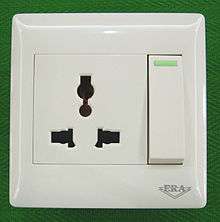 A so-called 'universal socket', which meets no standard[34] but is intended to accept a number of different plug types.
A so-called 'universal socket', which meets no standard[34] but is intended to accept a number of different plug types. An earthed Thai socket that appears to comply with figure 4 of TIS 166-2549. Although it may accept NEMA plugs, the Thai voltage is 220 V and thus electrically incompatible with US devices.
An earthed Thai socket that appears to comply with figure 4 of TIS 166-2549. Although it may accept NEMA plugs, the Thai voltage is 220 V and thus electrically incompatible with US devices.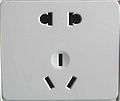 Chinese dual socket accepting both unearthed 2-pin (upper) and earthed 3-pin (lower) plugs.
Chinese dual socket accepting both unearthed 2-pin (upper) and earthed 3-pin (lower) plugs.
Voltage rating of plugs and power cords

Plugs and power cords have a rated voltage (V) and rated current (A) assigned to them by the manufacturer, and these values are required by IEC 60884-1 (which might not be legally binding in a given country) to be marked on the plug.[35] Using an appliance, plug, or power cord that is inappropriate for the load may be a safety hazard. For example, high-current equipment can cause a fire when plugged into an extension cord with a current rating lower than necessary. Sometimes the cords used to plug in dual voltage 120 V / 240 V equipment are rated only for 125 V, so care must be taken by travellers to use only cords with an appropriate voltage rating.
Appliance connections and extensions
So that manufacturers need not build, distribute and maintain many similar appliances differing only in the type of plug fitted, a common strategy is to provide an IEC 60320 inlet on the appliance and a detachable power cord (mains flex lead) to allow connection of the appliance to the socket. The appliance need only to be tested to the power inlet. Some types of appliance require the consumer to also change a switch to adapt to different voltages or frequency. In addition to sockets permanently attached to building wiring, extension cords (extension leads) are used for temporary connections when a socket is not within convenient reach of an appliance's power lead. A power strip can also include switching, surge voltage and over-current protection.
Adapters and converters
Plugs and sockets are usually designed as a system to meet standards for safety and reliability. Occasionally, plug and socket combinations may allow power to flow but may not meet product standards for mating force, earthing, current capacity, life expectancy, or safety. Failure to meet quality standards is even more likely when using third-party adapters or improvised user-modified connectors. Physical compatibility does not always ensure that the appliance and socket match in frequency or voltage. Retailers generally distinguish between travel adapters which transform physical connection but not voltage, converters which transform physical connection and voltage. Mismatch in frequency between supply and appliances may still cause problems even at the correct voltage.
Differences in pin length
Type I plugs and sockets from different countries have different pin lengths. This means that the uninsulated pins of a Chinese plug may become live while there is still a large enough gap between the faces of the plug and socket to allow a finger to touch the pin.
Special purpose plugs and sockets
Special purpose sockets may be found in residential, industrial, commercial or institutional buildings. Examples of systems using special purpose sockets include:
- "Clean" (low electrical noise) earth for use with computer systems,
- Electric car charging, IEC 62196, SAE J1772, Type 2 connector,
- Emergency power supply,
- Uninterruptible power supply for critical or life-support equipment,
- Isolated power for medical instruments, tools used in wet conditions, or electric razors,
- "Balanced" or "technical" power used in audio and video production studios,
- Theatrical lighting,
- Sockets for electric clothes dryers, electric ovens, and air conditioners with higher current rating.
Special-purpose sockets may be labelled or coloured to identify a reserved use of a system, or may have keys or specially shaped pins to prevent use of unintended equipment.
Shaver supply units
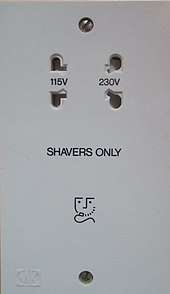
National wiring regulations sometimes prohibit the use of sockets within certain areas adjacent to water taps, etc. In such cases shaver supply units meeting IEC 61558-2-5 may be permissible. This has been adopted as a European CENELEC standard EN 61558-2-5 and also as a national standard in some countries, e.g. UK (BS EN 61558-2-5) and Malaysia (MS IEC 61558-2-5).
For such shaver supply units, an isolation transformer is required, and sockets usually accept multiple two-pin plug types including Europlug (Type C), Australian (Type I) and BS 4573. The isolation transformer often includes a 115 V output accepting two-pin US plugs (Type A). Shaver supply units must also be current limited, IEC 61558-2-5 specifies a minimum rating of 20 VA and maximum of 50 VA.[36] IEC 61558-2-5 requires sockets to be marked with the shaver symbol defined in IEC 60417-5225, the words "shavers only" are also often used but not required.
Types in present use
There are two common standards for voltage and frequency in the world. One is the European standard of 220–240 volts at 50 Hz,[37] and the other is the North American standard of 120 volts at a frequency of 60 Hz.[38] Japan uses 100 V with either 50 or 60 Hz.[39] The differences arose for historical reasons as discussed in the article Mains electricity. Many, but not all, systems of plugs and sockets are associated with one or the other voltage levels.
The plugs and sockets used in a given area are regulated broadly by national or local standards (see Mains electricity by country for a complete list) and more specifically by building regulations which may be set by local governments.
The International Electrotechnical Commission (IEC) maintains a guide documenting letter designations for generally compatible types of plugs,[40] which expands on earlier guides published by the United States Department of Commerce.[41] These guides were originally published for US citizens travelling or working in other countries. However, presently the IEC letter codes are often used internationally as a de facto naming standard when comparing different AC power plugs, especially when describing travel adaptors. Some letter types are associated with multiple variants (sometimes with different current ratings or for special purposes) and different standards in different countries, so a letter does not necessarily uniquely identify a specific plug or socket within the type family and does not guarantee compatibility of any plug and socket with the same letter (see #Comparison of standard types). Physical compatibility of the plug and socket system type also does not necessarily guarantee correct voltage, frequency, or current capacity for a given appliance or application. Not all plug and socket families have letters in the IEC guide, but those that have are noted in this article, as are some additional letters commonly used by retail vendors.
In Europe, the European Committee for Electrotechnical Standardization (CENELEC) publishes a list of approved plug and socket standards used in the member countries.[42]
Argentina IRAM 2073 and 2071 and compatible types (Type I)
The plug and socket used in Class 1 applications in Argentina is defined by IRAM. The applicable standards are: IRAM 2073 "Two pole plugs with earthing contact for domestic and similar purposes, rated 10 A and 20 A, 250 V AC" and IRAM 2071 "Two pole socket – outlets with earthing contact for 10 A and 20 A, 250 V AC., for fixed installations." It is similar in appearance to the Australasian and Chinese plugs. It has an earthing pin and two flat current-carrying pins forming an upside down V-shape (120°). The flat pins for the 10 A version measure 6.25 by 1.55 mm (0.246 by 0.061 in) and 8.0 by 1.9 mm (0.315 by 0.075 in) for the 20 A version, and are set at 30° to the vertical at a nominal pitch of 7.92 mm (0.312 in). The pin length is the same as in the Chinese version. The earthing pin length is 21.4 mm (0.843 in) for the 10 A version and 21.8 mm (0.858 in) for the 20 A version. The poles plugs length is 18.2 mm (0.717 in) for the 10 A version and 17.8 mm (0.701 in) for the 20 A version. The most important difference from the Australian plug is that the Argentinian plug is wired with the line and neutral contacts reversed.
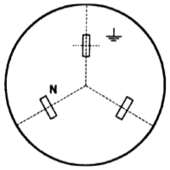
In Brazil, similar plugs and sockets are still commonly used for high-power appliances like air conditioners, dishwashers, and household ovens. Although being often called "Argentinian plug," it is actually based on the American NEMA 10-20 standard, and is incompatible with Argentinian IRAM plugs. Since Brazil adopted the NBR 14136 standard which includes a 20 A version, the original motivation to use the NEMA 10-20 plug has ceased to exist.
Australasian standard AS/NZS 3112 (Type I)
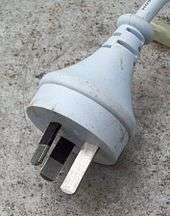

The plug used in Australia, New Zealand, Fiji, Tonga, Solomon Islands, and Papua New Guinea has an earthing pin and two flat current-carrying pins forming an upside down V-shape.[43] The flat pins measure 6.5 by 1.6 mm (0.256 by 0.063 in) and are set at 30° to the vertical at a nominal pitch of 13.7 mm (0.539 in). Australian and New Zealand wall sockets almost always have switches on them for extra safety, as in the UK. An unearthed version of this plug with two angled power pins but no earthing pin is used with small double-insulated appliances, but the sockets always include an earth contact.
There are several AS/NZS 3112 plug variants, including ones with larger or differently shaped pins used for devices drawing 15, 20, 25 and 32 A. These sockets accept plugs of equal or of a lower current capacity, but not of higher capacity. For example, a 10 A plug will fit all sockets but a 20 A plug will fit only 20, 25 and 32 A sockets. In New Zealand PDL 940 "Tap-on" or Piggy-back plugs are available which allow a second 10 A plug, or a charger, to be fitted to the rear of the plug.
Australia's standard plug/socket system was originally codified as standard C112 (floated provisionally in 1937, and adopted as a formal standard in 1938), which was superseded by AS 3112 in 1990. The requirement for insulated pins was introduced in the 2004 revision.[44] The current version is AS/NZS 3112:2011, Approval and test specification – Plugs and socket-outlets.
Brazilian standard NBR 14136 (Type N)
Brazil, which had been using mostly Europlugs, and NEMA 1–15 and NEMA 5–15 standards, adopted a (non-compliant) variant of IEC 60906-1 as the national standard in 1998 under specification NBR 14136 (revised in 2002).[45] These are used for both 220 volt and 127 volt regions of the country, despite the IEC 60906-2 recommendation that NEMA 5-15 be used for 120 V connections. There are two types of sockets and plugs in NBR 14136: one for 10 A, with a 4.0 mm pin diameter, and another for 20 A, with a 4.8 mm pin diameter.[46] This differs from IEC 60906-1 which specifies a pin diameter of 4.5 mm and a rating of 16 A. NBR 14136 does not require shutters on the apertures, a further aspect of non-compliance with IEC 60906-1. NBR 14136 was not enforced in that country until 2007, when its adoption was made optional for manufacturers. It became compulsory on 1 January 2010.
Few private houses in Brazil have an earthed supply, so even if a three-pin socket is present it is not safe to assume that all three terminals are actually connected. Most large domestic appliances were sold with the option to fit a flying earth tail to be locally earthed, but many consumers were unsure how to use this and so didn't connect it. The new standard has an earth pin, which in theory eliminates the need for the flying earth tail.[47]

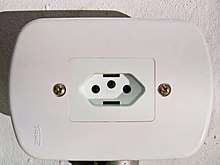
British and compatible standards
BS 546 and related types (Type D and M)

BS 546, "Two-pole and earthing-pin plugs, socket-outlets and socket-outlet adaptors for AC (50-60 Hz) circuits up to 250V" describes four sizes of plug rated at 2 A, 5 A (Type D), 15 A (Type M) and 30 A. The plugs have three round pins arranged in a triangle, with the larger top pin being the earthing pin. The plugs are polarized and unfused. Plugs are non-interchangeable between current ratings. Introduced in 1934, the BS 546 type has mostly been displaced in the UK by plugs and sockets to the BS 1363 standard. According to the IEC[48] some 40 countries use Type D and 15 countries use Type M. Some, such as India and South Africa, use standards based on BS 546.
BS 1363 (Type G)
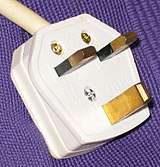
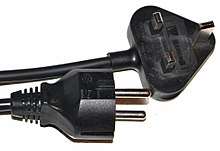
BS 1363 "13 A plugs, socket-outlets, adaptors and connection units"[49] is the main plug and socket type used in the United Kingdom. According to the IEC[40] it is also used in over 50 countries worldwide. Some of these countries have national standards based on BS 1363, including: Ireland, Malaysia, Malta, Singapore, and Saudi Arabia.
This plug, commonly called a 13 A plug or 13 amp plug, has three rectangular pins forming an isosceles triangle. The BS 1363 plug has a fuse which is suitably rated to protect the appliance's flexible cord from overload.
BS 4573 (UK shaver)

In the United Kingdom, Ireland, and Malta, there is a two-pin plug and socket for use with electric shavers and toothbrushes, defined by the BS 4573 standard.[50] The plug has insulated sleeves on the pins. Shaver sockets are normally incorporated into shaver supply units which include an isolation transformer and meet the safety requirements of the BS EN 61558-2-5 standard.[51] These are commonly found in bathrooms, and typically accept a variety of ~230 V two-pin plug types including BS 4573, Europlug Type C, and Australian two-pin plugs. The isolation transformer often includes a 115 V output to allow it to be used with a two-pin US Type A plug. These sockets are required by both standards to be marked with a shaver icon, and may optionally also be marked "shavers only".
CEE 7 standards
The International Commission on the Rules for the Approval of Electrical Equipment (IECEE) was a standards body which published Specification for plugs and socket-outlets for domestic and similar purposes as CEE Publication 7, known simply as CEE 7. It was originally published in 1951, the 2nd edition was published in May 1963 and was last updated by Modification 4 in March 1983.[52] CEE 7 consists of general specifications, plus a number of standard sheets for specific connectors.
A number of standards based on two round pins with centres spaced at 19 mm are in use in continental Europe and elsewhere, most of which are listed in IEC/TR 60083 "Plugs and socket-outlets for domestic and similar general use standardized in member countries of IEC".[53] There is no European Union regulation of domestic mains plugs and sockets, and the Low Voltage Directive specifically excludes domestic plugs and sockets.[32] EU countries each have their own regulations and national standards; for example, some require child-resistant shutters, while others do not. CE marking is neither applicable nor permitted on plugs and sockets.
CEE 7/1 unearthed socket and CEE 7/2 unearthed plug
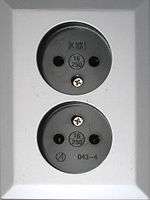
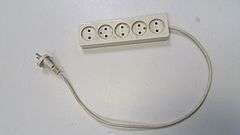

CEE 7/1 unearthed sockets are designed to accept CEE 7/2 round plugs without notches in the body and having 4.8 by 19 mm (0.189 by 0.748 in) pins.
Because they have no earth connections they have been or are being phased out in most countries. The regulations of countries using the CEE 7/3 and CEE 7/5 socket standards vary in whether CEE 7/1 sockets are still permitted in environments where the need for earthing is less critical. Sweden, for example, prohibited them from new installations in 1994. In Germany unearthed sockets are rare, whereas in the Netherlands and Sweden it is still common to find them in "dry areas" such as in bedrooms or living rooms. Some countries prohibit use of unearthed and earthed sockets in the same room, in the "insulated room" concept, so that people cannot touch an earthed object and one that has become live, at the same time.
The depth of the sockets varies between countries and age. Older sockets are so shallow that it is possible to touch the pins of a plug when the plug is inserted only deep enough to get electrical power on the pins, while newer sockets are deep enough to protect from this kind of accident. CEE 7/1 sockets accept CEE 7/4, CEE 7/6 and CEE 7/7 plugs without providing an earth connection. The earthed CEE 7/3 and CEE 7/5 sockets were specifically designed not to allow insertion of CEE 7/2 unearthed round plugs fitted to older appliances which had to be earthed via other means.
_socket-outlets%2C_with_and_without_shutters.jpg)
CEE 7/3 socket and CEE 7/4 plug (German "Schuko"; Type F)

The CEE 7/3 socket and CEE 7/4 plug are commonly called Schuko. The socket (which is often, in error, also referred to as CEE 7/4) has a predominantly circular recess which is 17.5 mm (0.689 in) deep with two symmetrical round apertures and two earthing clips on the sides of the socket positioned to ensure that the earth is always engaged before live pin contact is made. The plug pins are 4.8 by 19 mm (0.189 by 0.748 in). The Schuko connection system is symmetrical and unpolarised in its design, allowing line and neutral to be reversed. The socket also accepts Europlugs and CEE 7/17 plugs. It is rated at 16 A. The current German standards are DIN 49441:1972-06 "Two-pole plugs with earthing-contact 10 A 250 V≅ and 10 A 250 V–, 16 A 250 V∼" (which also includes CEE 7/7 plug) and DIN 49440-1:2006-01 "Two-pole socket-outlets with earthing contact, 16 A 250 V a.c." In addition to Germany, it is used in Albania, Austria, Belarus, Bosnia and Herzegovina, Bulgaria, Chile, Croatia, Denmark, Estonia, Finland, Greece, Hungary, Iceland, Indonesia, Iran, Italy (standard CEI 23-50), Kazakhstan, Latvia, Lithuania, Luxembourg, Republic of Macedonia, Republic of Moldova, the Netherlands, Norway, Pakistan, Portugal, Romania, Russia,[54] Serbia, Slovenia, South Korea[55], Spain, Sweden, Turkey, Ukraine, and Uruguay.
Schuko is an abbreviation for the German word Schutzkontakt, which means "Protective contact" - in this case "protective" refers to the earth.
Some countries, including South Korea, Portugal, Finland, Denmark,[56] Norway and Sweden, require child-proof socket shutters; the German DIN 49440-1:2006-01 standard does not have this requirement.
CEE 7/5 socket and CEE 7/6 plug (French; Type E)

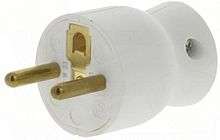
The CEE 7/5 socket and CEE 7/6 plug are defined in French standard NF C 61-314 "Plugs and socket-outlets for household and similar purposes" (which also includes CEE 7/7, 7/16 and 7/17 plugs) The socket has a predominantly circular recess which is 15 mm (0.591 in) deep with two symmetrical round apertures and a round 4.8 mm (0.189 in) earth pin projecting from the socket such that the tip is 23 mm (0.906 in) beyond the live contacts, to ensure that the earth is always engaged before live pin contact is made. The earth pin is centred between the apertures, offset by 10 mm (0.394 in). The plug (which is often, in error, also referred to as CEE 7/5) has two round pins measuring 4.8 by 19 mm (0.189 by 0.748 in), spaced 19 mm (0.748 in) apart and with an aperture for the socket's projecting earth pin. This standard is also used in Belgium, Poland, the Czech Republic, Slovakia and some other countries.
Although the plug is polarised, CEE 7 does not define the placement of the line and neutral and there is no universally-observed standard. However, the Czech standard recommends that the line wire be on the left side when facing the socket. The French convention changed circa 2002 from nothing particular, to, if the earth pin was at the top then the line hole in the socket would be on the right looking at the socket. However, the socket may not necessarily be installed with the earth pin at the top. Packaging in France of sockets is normally marked with correct connection of the cables. Polarised pre-fitted plugs on appliances are therefore connected with the brown line wire to the right pin and the blue neutral wire to the left, the earth being connected to the contact at the "top" of the plug.
CEE 7/2 and 7/4 plugs are not compatible with the CEE 7/5 socket because of the round earthing pin permanently mounted in the socket.
CEE 7/7 plug (compatible with E and F)

To bridge the differences between German and French standards, the CEE 7/7 plug was developed. It is polarised to prevent the line and neutral connections from being reversed when used with a French CEE 7/5 socket, but allows polarity reversal when inserted into a German CEE 7/3 socket. The plug is rated at 16 A.
It has earthing clips on both sides to connect with the CEE 7/3 socket and a female contact to accept the earthing pin of the CEE 7/5 socket. Currently, appliances in many countries are sold with non-rewireable CEE 7/7 plugs attached, enabling use in all countries whose socket standards are based on either CEE 7/3 or CEE 7/5.
CEE 7/16 plugs
The CEE 7/16 standard sheet appears in Supplement 2 (June 1962) to the 1951 edition of CEE 7. The CEE 7/16 unearthed plug is used for low power Class II applications, it has two round 4 by 19 mm (0.157 by 0.748 in) pins, rated at 2.5 A. There are two variants.
CEE 7/16 Alternative I
Alternative I is a round plug with cutouts to make it compatible with CEE 7/3 and CEE 7/5 sockets. Although it is similar in appearance to CEE 7/17 it has narrower pins (4 mm) and a lower current rating (maximum 2.5 A). This alternative is seldom used.
CEE 7/16 Alternative II "Europlug" (Type C)
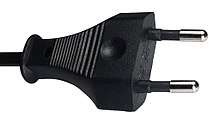
Alternative II, popularly known as the Europlug, is a flat plug. It is also defined by Cenelec standard EN 50075 "Flat non-rewirable two-pole plugs, 2.5 A 250 V, with cord, for the connection of class II-equipment for household and similar purposes", which has national equivalents in most European countries, as described in IEC 60083. The Europlug is not rewirable and must be supplied with a flexible cord. Because it is unpolarised, it can be inserted in either direction into a socket, so line and neutral are connected arbitrarily.
Plugs and sockets are usually designed together, with the contacts of the socket part designed to accept the specific pin diameter, pin length, and pin spacing of the mating plug part. However, there is no socket defined by EN 50075; neither is there a socket specified in CEE 7 to accept only 4 mm (0.157 in) pins or the profile of a Europlug. (There are examples of sockets on the market which accept only such plugs, sometimes in multiples, but these meet no recognized standard.) Instead of being designed with a matching socket, the Europlug was designed to be compatible with a range of sockets in common use throughout mainland Europe. These sockets, including the CEE 7/1, CEE 7/3 (German/"Schuko"), CEE 7/5 (French), and most Israeli, Swiss, Danish and Italian sockets, were designed to accept pins of various diameters, mainly 4.8 mm but also 4.0 mm and 4.5 mm, and are usually fed by final circuits with either 10 A or 16 A overcurrent protection devices.[57] To improve contact with socket parts intended to receive pins having a diameter larger than 4.0 mm, the Europlug has two round, slightly flexible pins which converge slightly towards their free ends.
The Europlug is physically not compatible with BS 1363 13 A sockets, however most modern UK dedicated shaver sockets designed to accept BS 4573 shaver plugs also accept Europlugs for applications requiring less than 200 mA.[58] Other than such personal hygiene applications, UK consumer protection legislation[59] does not permit the supply of appliances fitted with Europlugs.
Apart from use in continental Europe, the Europlug is also used in the Middle East (Iran), most African nations, South America (Argentina, Bolivia, Brazil, Chile, Peru and Uruguay), Asia (India, Bangladesh, Sri Lanka, Indonesia, Pakistan, China, South Korea, Thailand, Philippines, Malaysia and Singapore) as well as Russia and the former Soviet republics, such as Ukraine, Armenia, Georgia, and many developing nations. Where permitted it is also used, by means of adaptors, in many nations, particularly former British colonies, which use the BS 1363 standard.
CEE 7/17 unearthed plug

This is a round plug which conforms to a shape compatible with CEE 7/1, CEE 7/3, and CEE 7/5 sockets. It has two round pins measuring 4.8 by 19 mm (0.189 by 0.748 in). It may be rated at either 10 A or 16 A, and may be used for unearthed Class II appliances (and in South Korea for all domestic non-earthed appliances). It is also defined as the Class II plug in Italian standard CEI 23-50. It can be inserted into Israeli SI 32 with some difficulty. The Soviet GOST 7396 standard includes both the CEE 7/17 and the CEE 7/16 variant II plug.
Danish Section 107-2-D1 earthed (Type K)
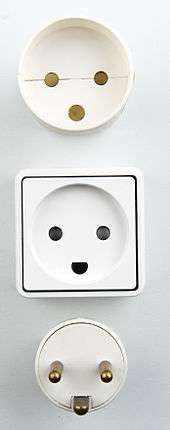

This Danish standard plug is described in the Danish Plug Equipment Section 107-2-D1 Standard sheet (SRAF1962/DB 16/87 DN10A-R). Unlike the French CEE 7/6 plug, the earthing pin is on the plug, not in the socket[60]. The Danish socket need not be recessed to protect the earthing pin. The Danish standard provides for sockets to have child-resistant shutters.
The Danish socket will also accept the CEE 7/16 Europlug or CEE 7/17 Schuko-French hybrid plug. CEE 7/4 (Schuko), CEE 7/7 (Schuko-French hybrid), and earthed CEE 7/6 French plugs will also fit into the socket but will not provide an earth connection and may be attached to appliances requiring more than the 13 A maximum rating of the socket.
A variation (standard DK 2-5a) of the Danish plug is for use only on surge protected computer sockets. It fits into the corresponding computer socket and the normal socket, but normal plugs deliberately don't fit into the special computer socket. The plug is often used in companies, but rarely in private homes.
There is a variation for hospital equipment with a rectangular left pin, which is used for life support equipment.
Traditionally all Danish sockets were equipped with a switch to prevent touching live pins when connecting/disconnecting the plug. Today, sockets without switch are allowed, but then it is a requirement that the sockets have a cavity to prevent touching the live pins. The shape of the plugs generally makes it difficult to touch the pins when connecting/disconnecting.
Since the early 1990s earthed sockets have been required in all new electric installations in Denmark. Older sockets need not be earthed, but all sockets, including old installations, must be protected by earth-fault interrupters (HFI or HPFI in Danish) by 1 July 2008.
As of 1 July 2008, wall sockets for French 2-pin, female earth CEE 7/5 are permitted for installations in Denmark.[61] This was done because no electrical equipment sold to private users is equipped with a Danish plug.
Sockets for the Schuko were not permitted until 15 November 2011. Many international travel adaptor sets sold outside Denmark match CEE 7/16 (Europlug) and CEE 7/7 (Schuko-French hybrid) plugs which can readily be used in Denmark.
Denmark has allowed CEE 7/3 "Schuko" sockets since 15 November 2011.[62]
Italy (Type L)

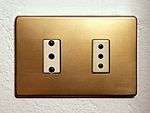
Italian plugs and sockets are defined by the standard CEI 23-50 which superseded CEI 23-16. This includes models rated at 10 A and 16 A that differ in contact diameter and spacing (see below for details)[63]. Both are symmetrical, allowing the line and neutral contacts to be inserted in either direction. This plug is also commonly used in Chile and Uruguay.
- 10 A plugs and socket
- Pins which are 4 mm in diameter, the centres spaced 19 mm apart. The 10 A three-pin earthed rear entry plug is designated CEI 23-50 S 11 (there are also two side-entry versions, SPA 11 and SPB 11). The 10 A two-pin unearthed plug is designated CEI 23-50 S 10. The 10 A three-pin earthed socket is designated CEI 23-50 P 11, and the 10 A two-pin unearthed socket is designated CEI 23-50 P 10. Both 10 A sockets also accept CEE 7/16 (Europlugs).
- 16 A plug and socket
- Pins which are 5 mm in diameter, the centres spaced 26 mm apart. The 16 A three-pin earthed rear entry plug is designated CEI 23-50 S 17 (there are also two side-entry versions, SPA 17 and SPB 17). The 16 A two-pin unearthed plug is designated CEI 23-50 S 16. The 16 A three-pin earthed socket is designated CEI 23-50 P 17, there is not a 16 A two-pin unearthed socket. The 16 A socket used to be referred to as per la forza motrice[64] (for electromotive force, see above) or sometimes (inappropriately) industriale (industrial) or even calore.
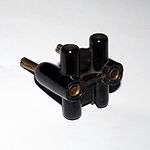
The two standards were initially adopted because up to the second half of the 20th century in many regions of Italy electricity was supplied by means of two separate consumer connections – one for powering illumination and one for other purposes – and these generally operated at different voltages, typically 127 V single phase and 220 V single phase (from 3-phase 380 V) or two phase (from 220 V 3-phase). The electricity on the two supplies was separately metered, was sold at different tariffs, was taxed differently and was supplied through separate and different sockets.[65] Even though the two electric lines (and respective tariffs) were gradually unified beginning in the 1960s (the official, but purely theoretical date was the summer of 1974)[66] many houses had dual wiring and two electricity meters for years thereafter; in some zones of Lazio the 127 V network was provided for lighting until 1999. The two gauges for plugs and sockets thus became a de facto standard which is now formalized under CEI 23-50. Some older installations have sockets that are limited to either the 10 A or the 16 A style plug, requiring the use of an adaptor if the other gauge needs to be connected. Numerous cross adaptors were used.
Almost every appliance sold in Italy nowadays is equipped with CEE 7/7 (German/French), CEE 7/16 or CEE 7/17 plugs, but the standard Italian sockets will not accept the first and the third ones since the pins of the CEE 7/7 and CEE 7/17 plugs are thicker (4.8 mm) than the Italian ones (4 mm); besides the pins are not sheathed and forcing them into a linear Italian socket may lead to electric shock. Adaptors are standardized in Italy under CEI 23-57 which can be used to connect CEE 7/7 and CEE 7/17 and plugs to linear CEI 23-50 sockets.
Europlugs are also in common use in Italy; they are standardized under CEI 23-34 S 1 for use with the 10 A socket and can be found fitted to Class II appliances with low current requirement (less than 2.5 A).
The current Italian standards provide for sockets to have child-resistant shutters ("Sicury" patent).[67]
Italian multiple standard sockets

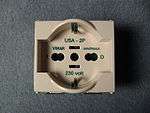
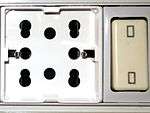
In modern installations in Italy (and in other countries where Type L plugs are used) it is usual to find sockets that can accept more than one standard.
The simplest type, designated CEI 23-50 P 17/11, has a central round hole flanked by two figure-8 shaped holes, allowing the insertion of CEI 23-50 S 10 (Italian 10 A plug unearthed), CEI 23-50 S 11 (Italian 10 A plug earthed), CEI 23-50 S 16 (Italian 16 A plug unearthed), CEI 23-50 S 17 (Italian 16 A plug earthed) and CEE 7/16 (Europlug). The advantage of this socket style is its small, compact face; its drawback is that it accepts neither CEE 7/7 nor CEE 7/17, very commonly found in new appliances sold in Italy. Vimar brand claims to have patented this socket first in 1975[68] with their Bpresa model; however soon other brands started selling similar products, mostly naming them with the generic term presa bipasso (twin-gauge socket) that is now of common use.
A second, quite common type is called CEI 23-50 P 30 and looks like a Schuko socket, but adds a central earthing hole (optional according to CEI 23-50, but virtually always present). This design can accept CEE 7/4 (German), CEE 7/7 (German/French), CEE 7/16, CEE 7/17 (Konturenstecker, German/French unearthed), CEI 23-50 S 10 and CEI 23-50 S 11 plugs. Its drawback is that it is twice as large as a normal Italian socket, it does not accept 16 A Italian plugs and the price is higher; for those reasons Schuko sockets have been rarely installed in Italy until recent times.
Other types may push compatibility even further. The CEI 23-50 P 40 socket, which is quickly becoming the standard in Italy along with CEI 23-50 P 17/11, accepts CEE 7/4, CEE 7/7, CEE 7/16, CEE 7/17, CEI 23-50 S 10, CEI 23-50 S 11, CEI 23-50 S 16 and CEI 23-50 S 17 plugs; its drawback is that it does not accept SPA 11, SPB 11, SPA 17 and SPB 17 side-entry plugs; however almost no appliance is sold with these types, which are mainly used to replace existing plugs. The Vimar-brand universale (all purpose) socket accepts CEE 7/4, CEE 7/7, CEE 7/16, CEE 7/17, CEI 23-50 S 10, CEI 23-50 S 11, CEI 23-50 S 16, CEI 23-50 S 17 and also NEMA 1-15 (US/Japan) plugs (older versions also had extra holes to accept UK shaver plugs).
Soviet standard GOST 7396 C 1 unearthed
This Soviet plug, still widely used in modern Russia, has pin dimensions and spacing equal to the Europlug, but lacks the insulation sleeves. Unlike the Europlug, it is rated 6 A. It has a round body like the French CEE 7/6 or flat body with a round base like CEE 7/17. The round base has no notches. The pins are parallel and do not converge. The body is made of fire resistant thermoset plastic. The corresponding 6 A socket accepts the Europlug, but not others as the 4.5 mm holes are too small to accept the 4.8 mm pins of CEE 7/4, CEE 7/6 or CEE 7/7 plugs.
There were also moulded rubber plugs available for devices up to 16 A similar to CEE 7/17, but with a round base without any notches. They could be altered to fit a CEE 7/5 or CEE 7/3 socket by cutting notches with a sharp knife.
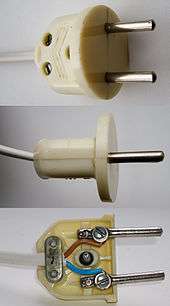 Soviet grip plug, 6 A 250 V AC, thermoset plastic
Soviet grip plug, 6 A 250 V AC, thermoset plastic Soviet round plug, 6 A 250 V AC, thermoset plastic, half height
Soviet round plug, 6 A 250 V AC, thermoset plastic, half height Moulded rubber Soviet plugs cut with knife so that they can fit into CEE 7/3 socket. Originally the plugs had a round base.
Moulded rubber Soviet plugs cut with knife so that they can fit into CEE 7/3 socket. Originally the plugs had a round base. Soviet shaver power cord. The plug is similar to CEE7/16, but has different configuration. Thermoplastic plug is rated 6 A and 250 V.
Soviet shaver power cord. The plug is similar to CEE7/16, but has different configuration. Thermoplastic plug is rated 6 A and 250 V.
Swiss SEV 1011

The Swiss standard, also used in Liechtenstein,[69] is SN SEV 1011:2009 Plugs and socket-outlets for household and similar purposes.[70] The standard defines a hierarchical system of plugs and sockets with two, three and five pins, and 10 A or 16 A ratings. Sockets will accept plugs with the same or fewer pins and the same or lower ratings.[71]

The three phase variants of the standard are also described at Industrial and multiphase power plugs and sockets § Switzerland: SEV 1011.
All of the single phase connectors are rated at 250 V. The three-phase connectors are rated at 250 V (phase-to-neutral) / 400 V (phase-to-phase).
The Swiss standard does not require the use of child protective shutters.
The Swiss standard was first described in SEV 1011 (ASE1011/1959 SW10A-R). On 4 December 2009, the TK23 Technical Committee issued the new revised edition of the Swiss standard SEV 1011:2009 for 10-A plugs and 11/12 sockets to provide, among other things, improved protection against contact with partially insulated pins can. As of 1 January 2013, imports into Switzerland of Type 11 and Type 12 plugs are only permitted with partially insulated plug pins. After the year 2016, only sockets type 13 with a recessed socket hole may be brought onto the market.
10 A plugs and sockets (Type J)
SEV 1011 defines a "Type 1x" series of 10 A plugs and sockets.
The type 11 plug is unearthed, with two 4 mm diameter round pins spaced 19 mm apart. The type 12 plug adds a central 4 mm diameter round earth pin, offset by 5 mm.
The type 12 socket has no recess, while the type 13 socket is recessed. Both sockets will accept type 11 and type 12 plugs, and also the 2.5 A Europlug. From 2017 only recessed sockets are permitted to be installed, minimizing the risk of electric shocks.[72]
Earlier type 11 & 12 plugs had line and neutral pins without sleeved pins, which present a shock hazard when partially inserted into non-recessed sockets. Since 1 January 2013, only type 11 & 12 plugs with line and neutral pins partially sleeved are allowed to be imported and distributed to reduce the risk.[73]
The IEC type J designation refers to SEV 1011's type 12 plugs and type 13 sockets.[69]
Unique to Switzerland is a three-phase power socket compatible with single-phase plugs:[71]
The type 15 plug has three round pins, of the same dimensions as type 12, plus two smaller flat rectangular pins for two additional power phases. The type 15 socket is recessed, and has five openings (three round and two flat rectangular). It will accept plugs of types 11, 12, 15 and the Europlug.
16 A plugs and sockets
SEV 1011 also defines a "Type 2x" series of 16 A plugs and sockets. These are the same as their 10 A "Type 1x" counterparts, but replace the round pins with 4 mm × 5 mm rectangular pins. The sockets will accept "Type 1x" plugs.
The unearthed type 21 plug has two rectangular pins, with centres 19 mm apart. The type 23 plug adds a central rectangular earth pin, offset by 5 mm.
The recessed type 23 socket will accept plugs of types 11, 12, 21, 23 and the Europlug.
Again, the three-phase power socket is compatible with single-phase plugs, either of 10 A or 16 A ratings:[71]
The type 25 plug has three rectangular pins of the same dimensions as type 23, plus two rectangular pins of the same dimensions as type 15. The corresponding type 25 socket is recessed and will accept plugs of types 11, 12, 15, 21, 23, 25 and the Europlug.
Adaptors etc.
A 2012 appendix to SEV 1011:2009, SN SEV 1011:2009/A1:2012 Plugs and socket-outlets for household and similar purposes – A1: Multiway and intermediate adaptors, cord sets, cord extension sets, travel adaptors and fixed adaptors[74] defines the requirements applicable to multiway and intermediate adaptors, cord sets, cord extension sets, and travel and fixed adaptors, it covers the electrical safety and user requirements, including the prohibition of stacking (the connection of one adaptor to another). Non-conforming products must be withdrawn from the Swiss market before the end of 2018.[75]
- Swiss sockets
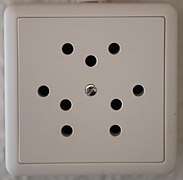 Type 12 triple socket (10 A), no longer sold or installed
Type 12 triple socket (10 A), no longer sold or installed Type 13 triple socket (10 A)
Type 13 triple socket (10 A)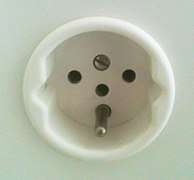 Very outdated Type 14 socket
Very outdated Type 14 socket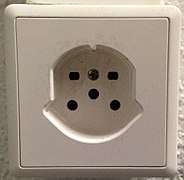 Type 15 socket (3-phase, 10 A)
Type 15 socket (3-phase, 10 A) Type 23 triple socket (16 A)
Type 23 triple socket (16 A) Type 25 socket (3-phase, 16 A)
Type 25 socket (3-phase, 16 A)
IEC 60906-1 (Type N)
In 1986, the International Electrotechnical Commission published IEC 60906-1, a specification for a plug and socket that look similar, but are not identical, to the Swiss plug and socket. This standard was intended to one day become common for all of Europe and other regions with 230 V mains, but the effort to adopt it as a European Union standard was put on hold in the mid-1990s.[76]
The plug and socket are rated 16 A 250 V a.c. and are intended for use only on systems having nominal voltages between 200 V and 250 V a.c. The plug pins are 4.5 mm in diameter, line and neutral are on centres 19 mm apart. The earth pin is offset 3.0 mm. The line pin is on the left when looking at a socket with the earth pin offset down. Shutters over the line and neutral pins are mandatory.
The only country to have officially adopted the standard is South Africa as SANS 164-2.[77][78]
Brazil developed a plug resembling IEC 60906-1 as the national standard under specification NBR 14136.[45] The NBR 14136 standard has two versions, neither of which has pin dimensions or ratings complying to IEC 60906-1. Use at 125 V is permitted by NBR 14136, which is against the intention of IEC 60906-1.
China GB 2099.1‐2008 and GB 1002‐2008 (Type A & I)
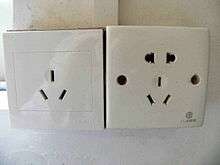
The standard for Chinese plugs and sockets (excluding Hong Kong and Macau) is set out in GB 2099.1‐2008 and GB 1002‐2008. As part of China's commitment for entry into the WTO, the new CPCS (Compulsory Product Certification System) has been introduced, and compliant Chinese plugs have been awarded the CCC Mark by this system. The plug is three wire, earthed, rated at 10 A, 250 V and used for Class 1 applications; a slightly larger 16 A version also exists. The nominal pin dimensions of the 10 A version are: 1.5 mm thick by 6.4 mm wide, the line & neutral are 18 mm long, and the earth is 21 mm long.[79] It is similar to the Australian plug. Many 3 pin sockets in China include a physical lockout preventing access to the active and neutral terminals unless an earth pin (which is slightly longer than the other 2 pins) is entered first. China also uses American/Japanese NEMA 1‐15 sockets and plugs for Class-II appliances; a common socket type that also accepts Europlug (type C) is also defined in GB 1002. The voltage at a Chinese socket of any type is 220 V.
Israel SI32 (Type H)

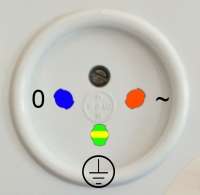
The plug defined in SI 32 (IS16A-R) is used only in Israel and in the territories of the West Bank and the Gaza Strip. There are two versions: an older one with flat pins, and a newer one with round pins.[80]
The pre-1989 system has three flat pins in a Y-shape, with line and neutral 19 mm (0.75 in) apart. The plug is rated at 16 A. In 1989 the standard was revised, with three round 4.5 mm (0.177 in) pins in the same locations designed to allow the socket to accept both older and newer Israeli plugs, and also non-earthed Europlugs (often used in Israel for equipment which does not need to be earthed and does not use more current than the Europlug is rated for).[80] Pre-1989 sockets which accept only old-style plugs have become very rare in Israel.
SI 32 plugs have no sleeve insulation, so when a plug is partially removed its prongs may still be powered although they can be touched by small fingers, metal objects, etc., with a risk of electric shock.
Sockets have a defined polarity; looking at the front, neutral is to the left, earth at the bottom, and line to the right.[81]
North American and IEC 60906-2
Most of North America and Central America, and some of South America, use connectors standardized by the National Electrical Manufacturers Association. The devices are named using the format NEMA n-mmX, where n is an identifier for the configuration of pins and blades, mm is the maximum amperage, and X is either P for plug or R for receptacle. For example, NEMA 5-15R is a configuration type 5 receptacle supporting 15 A. Corresponding P and R versions are designed to be mated. The prefix, L, is added for the locking types; a 15 A 120 V two-pole grounding plug is designated NEMA L5-15P. Twist-locking types are used for additional protection from accidental disconnection, or to prevent interchange with parallel blade types
For some configurations, the arrangement of pins will differ slightly for the different current ratings, to prevent accidental mating of devices with a higher current draw than the receptacle can support.
IEC 60906-2 is based on NEMA 5-15.
A brief description of some common NEMA standards appears below. A more comprehensive list, with more detail, appears in the NEMA connector article.
NEMA 1-15 ungrounded (Type A)


NEMA-1 plugs, rated 15 A at 125 volts, are compatible with both NEMA-1 receptacles and NEMA-5 receptacles; NEMA-1 is ungrounded (no earth), while NEMA 5 is grounded. The plug has two parallel blades. Early versions were not polarized, but most plugs are polarized today via a wider neutral blade on the plug that fits a wider neutral opening on the receptacle. (Unpolarized AC adaptors are a common exception.)
Harvey Hubbell patented a parallel blade plug in 1913, where the blades were equal width (US patent 1064833[82]). In 1916 Hubbell received a further patent for a polarized version where one blade was both longer and wider than the other (US patent 1180648[83]), in the polarized version of NEMA 1-15 both blades are the same length, only the width varies.
Ungrounded NEMA-1 outlets are not permitted in new building construction in the United States and Canada, but can still be commonly found in older construction. Allowed replacement of NEMA-1 receptacles varies by local code.
NEMA 5-15 grounded (Type B)

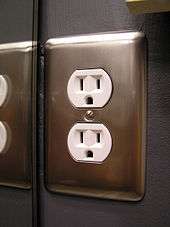
The NEMA 5-15 plug has two flat parallel blades like NEMA 1-15, but also adds a ground (earth) pin.[84] It is rated 15 A at 125 volts. The ground (earth) pin is longer than the line and neutral blades, so the device is grounded before the power is connected. Both current-carrying blades on grounding plugs are normally narrow, since the ground (earth) pin enforces polarity. NEMA 1-15 plugs are also compatible with NEMA 5-15 sockets.
The 5-15 socket is standard in Canada, the United States, Mexico and Panama. It is also used in Central America, the Caribbean, northern South America (Colombia, Ecuador, Venezuela and, as a legacy, parts of Brazil), Japan, Taiwan, the Philippines and Saudi Arabia. This socket is recommended in IEC standard 60906-2 for 120 volt 60 Hz installations. Looking directly at a NEMA 5-15 socket in the commonly found orientation of ground (earth) at the bottom, the neutral slot is on the left, and the line slot is on the right. However, in the US the National Electrical Installation Standards (NECA 130-2010)[85] specifies that the ground hole should be on top. Sideways installation is also permitted; in this case, NECA 130-2010 specifies the neutral (long) slot is on top and the ground hole on the left..
In 46 of the 50 United States[86] and all of Canada, tamper-resistant sockets are now required in new residential construction. These prevent contact by objects like keys or paper clips inserted into the socket.[87]
In stage lighting, this connector is sometimes known as PBG for Parallel Blade with Ground (earth), Edison or Hubbell, the name of a common manufacturer.[88]
NEMA 5-20
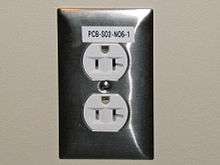
As NEMA 5 currents increase, changes are made to the plug's neutral blade so that it will not fit into sockets rated for a lower current. Some sockets rated for higher currents are designed to accept many shapes for the neutral blade, so that both high and low draw devices are compatible with it.
The NEMA 5-20 AP variant has a horizontal neutral blade (in a plane that would intersect the hot blade). The receptacle has a T-slot for the neutral blade which accepts either 15 A parallel-blade plugs or 20 A plugs.
NEMA 5-30 and 5-50 are rare; L5-30 and L5-50 twistlock is more common. The non-locking versions are physically incompatible with 5-15 and 5-20, as the hot/neutral blades are farther apart.
NEMA 14-30
A 30 A, 4-wire single-phase grounding socket is often used for electric clothes dryers. 240 volts from the split phase system is used for the heating elements, and the motor and controls run on 120 volts. These plugs have blades that are rather larger than NEMA 5-20, are more widely spaced, and are angled so as to prevent using the wrong plug in the wrong circuit. These plugs have L-shaped neutral blades that will not fit in a NEMA 14-50 receptacle.
NEMA 14-50
This is a 50 A, 4-wire grounding socket usually installed in kitchens and used for electric cooking ranges and ovens supplied with 240 V by the split phase system. Similar to dryers on 14-30 sockets, these usually have lights, fans, timers, etc., that are run from 120 V (obtained from one of the 120 legs to neutral). Many plug-in electric cars also use this type of socket for recharging in the owner's garage (but in this case neutral is not needed ). It is also commonly found in RV parks to provide electricity to recreational vehicles. These plugs have a straight neutral blade that will not fit in a NEMA 14-30 receptacle.
JIS C 8303, Class II unearthed



The Japanese plug and socket appear physically identical to NEMA 1-15. The Japanese system incorporates stricter dimensional requirements for the plug housing, different marking requirements, and mandatory testing and approval by METI or JIS.[89]
Older Japanese sockets and multi-plug adaptors are unpolarized – the slots in the sockets are the same size – and will accept only unpolarized plugs. Japanese plugs generally fit into most North American sockets without modification, but polarized North American plugs may require adaptors or replacement non-polarized plugs to connect to older Japanese sockets. In Japan the voltage is 100 V, and the frequency is either 50 Hz (East Japan) or 60 Hz (West Japan) depending on whether the customer is located on the Osaka or Tokyo grid.[90][91] Therefore, some North American devices which can be physically plugged into Japanese sockets may not function properly.
JIS C 8303, Class I earthed
Japan also uses a grounded plug similar to the North American NEMA 5-15.[89] However, it is less common than its NEMA 1-15 equivalent. Since 2005, new Japanese homes are required to have class I grounded sockets for connecting domestic appliances. This rule does not apply for sockets not intended to be used for domestic appliances, but it is strongly advised to have class I sockets throughout the home.[92]
Thai 3 pin plug TIS 166-2549

Thai Industrial Standard (TIS) 166-2547 and its subsequent update TIS 166-2549[93] replaced prior standards which were based on NEMA 1-15 and 5-15, as Thailand uses 220 V electricity. The plug has two round power pins 4.8 mm in diameter and 19 mm in length, insulated for 10 mm and spaced 19 mm apart, with an earthing pin of the same diameter and 21.4 mm in length, located 11.89 mm from the line connecting the two power pins. The earth pin spacing corresponds to that of NEMA 5 and provides compatibility with prior hybrid three-pin sockets, which accept NEMA 1-15, NEMA 5-15 and Europlugs, all of which have been variably used in Thailand. The hybrid socket is also defined in TIS 166-2547, in addition to a plain three-round-pin socket, with plans to replace the former and phase out support for NEMA-compatible plugs. Sockets are polarised (as in NEMA 5-15).[94] The plug is similar to, but not interchangeable with, the Israeli SI32 plug. The Thai plug has not been designated with a letter code at IEC World Plugs,[40] but is sometimes referred to and sold as "Type O".[95][96][97][98][99]
Comparison and compatibility of standard types
| IEC World Plugs Type[lower-alpha 1] |
Standard | Origin | Rating | Earthed
(Grounded) |
Polarised | Fused | Insulated pins |
Socket accepts Europlug | |
|---|---|---|---|---|---|---|---|---|---|
| A | NEMA 1-15 unpolarised | American | 15 A | 125 V | No | No | No | No | No |
| NEMA 1-15 polarised | American | 15 A | 125 V | No | Yes | No | No | No | |
| JIS C 8303, Class II | Japanese | 15 A | 125 V | No | No | No | No | No | |
| B | NEMA 5-15 | American | 15 A | 125 V | Yes[lower-alpha 2] | Yes | No | No | No |
| NEMA 5-20 | American | 20 A | 125 V | Yes[lower-alpha 2] | Yes | No | No | No | |
| JIS C 8303, Class I | Japanese | 15 A | 125 V | Yes[lower-alpha 2] | Yes | No | No | No | |
| C | CEE 7/16 | "Europlug" | 2.5 A | 250 V | No | No | No | Yes | N/A[lower-alpha 3] |
| - | CEE 7/17 plug[lower-alpha 4] | French / German hybrid |
16 A | 250 V | No | No[lower-alpha 5] | No | No | N/A[lower-alpha 3] |
| - | CEE 7/1 socket & CEE 7/2 plug | N/A | 10 A 16 A |
250 V | No[lower-alpha 6] | No | No | No | Yes |
| - | GOST 7396 C 1 | Russian | 6 A 16 A |
250 V | No | No | No | No | Yes |
| - | BS 4573 | British | 0.2 A | 250 V | No | No | No | Yes | No |
| Socket only; plug is unspecified[lower-alpha 7] | |||||||||
| D | BS 546 | British | 5 A | 250 V | Yes | Yes | Optional | Optional | No |
| IS 1293 and SANS 164-3 |
Indian and South African (respectively) |
6 A | 250 V | Yes | Yes | Optional | Optional | No | |
| E | CEE 7/5 socket & CEE 7/6 plug[lower-alpha 8][lower-alpha 4] | French | 16 A | 250 V | Yes[lower-alpha 2] | Yes[lower-alpha 9] | No | No[lower-alpha 10] | Yes |
| F | CEE 7/3 socket & CEE 7/4 plug[lower-alpha 8][lower-alpha 4] | German "Schuko" |
16 A | 250 V | Yes[lower-alpha 2] | No | No | No[lower-alpha 10] | Yes |
| - | CEE 7/7 plug[lower-alpha 8] | French / German hybrid |
16 A | 250 V | Yes | No | No | No[lower-alpha 10] | N/A[lower-alpha 3] |
| G | BS 1363, IS 401 & IS 411, MS 589, SS 145 | British | 13 A[lower-alpha 11] | 250 V | Yes | Yes | Yes | Yes | No |
| H | SI 32 | Israeli | 16 A | 250 V | Yes | Yes[lower-alpha 12] | No | No | Yes |
| I | AS/NZS 3112 | Australian and New Zealander |
10 A 15 A 20 A 25 A 32 A |
250 V | Yes[lower-alpha 2] | Yes | No | Yes | No |
| GB 1002 and GB 2099.1 |
Chinese | 10 A | 250 V | Yes | Yes | No | No | No | |
| IRAM 2073 | Argentinian | 10 A | 250 V | Yes | Yes | No | No | No | |
| J | SEV 1011:2009, Typ 12 plug and Typ 13 socket | Swiss | 10 A | 250 V | Yes[lower-alpha 2] | Yes | No | Yes[lower-alpha 13] | Yes |
| K | 107-2-D1 | Danish | 13 A | 250 V | Yes[lower-alpha 2] | Yes | No | No | Yes |
| L[lower-alpha 14] | CEI 23-50 (formerly CEI 23-16) | Italian | 10 A | 250 V | Yes[lower-alpha 2] | No | No | Yes | Yes |
| CEI 23-50 (formerly CEI 23-16) | Italian | 16 A | 250 V | Yes[lower-alpha 2] | No | No | Yes | No | |
| M | BS 546 | British | 15 A | 250 V | Yes | Yes | Optional | Optional | No |
| IS 1293 and SANS 164-1 |
Indian and South African (respectively) |
16 A | 250 V | Yes | Yes | Optional | Optional | No | |
| N | NBR 14136 2-pin | Brazilian | 10 A 20 A |
250 V | No | No | No | Yes | Yes |
| NBR 14136 3-pin | Brazilian | 10 A 20 A |
250 V | Yes[lower-alpha 2] | Yes | No | Yes | Yes | |
| SANS 164-2 2-pin | South African | 16 A | 250 V | No | No | No | Yes | Yes | |
| SANS 164-2 3-pin | South African | 16 A | 250 V | Yes[lower-alpha 2] | Yes | No | Yes | Yes | |
| - | TIS 166-2549 | Thai | 16 A | 250 V | Yes | Yes | No | Yes | Yes |
| IEC World Plugs Type[lower-alpha 1] |
Standard | Origin | Rating | Earthed | Polarised | Fused | Insulated pins |
Socket accepts Europlug | |
- 1 2 Type letters are from the International Electrotechnical Commission (IEC) Web site[40] that provides classification letters similar to a United States Department of Commerce publication[41] that sees widespread but not universal use to differentiate plug and socket types based on rough mechanical compatibility. Most common household plugs have an associated letter.
- 1 2 3 4 5 6 7 8 9 10 11 12 Will accept unearthed plugs.
- 1 2 3 Standard does not define a socket.
- 1 2 3 CEE 7/17 specifies an unearthed hybrid plug that will fit into both the CEE 7/3 and CEE 7/5 sockets.
- ↑ There are some CEE 7/17 plugs with special shape which are polarised when used with CEE 7/5 sockets (mechanically only).
- ↑ CEE 7/1 socket accepts earthed CEE 7/3, CEE 7/5 and CEE 7/7 plugs but provides no earth connection.
- ↑ BS 4573 and BS EN 61558-2-5 do not explicitly specify a current rating for a compliant plug, see BS 4573 section of British and compatible standards.
- 1 2 3 CEE 7/7 specifies an earthed hybrid plug that will fit into both the CEE 7/3 and CEE 7/5 sockets.
- ↑ Plug can only be inserted one way with French CEE 7/5, but lack of wiring convention means that the system is not polarized.
- 1 2 3 The recess provided by CEE 7/3 and CEE 7/5 sockets offers protection against touching the live pins of CEE 7/4, CEE 7/6 and CEE 7/7 plugs. When used in CEE 7/1 (unearthed) sockets, or "universal adaptors" there is no protection for those plugs.
- ↑ The actual rating of non-rewirable plugs is marked according to the fuse fitted by the cord set manufacturer, the fuse rating being determined by the rating of the flexible cable.
- ↑ Polarized on earthed versions only.
- ↑ Import of plugs with non-partially-insulated pins no longer allowed after 2012.
- ↑ Type L comes in two variations with ratings of 10 A & 16 A having different pin diameters and spacing from each other.
Compatibility
Plugs of type D, G, and M are physically incompatible with any other type other than their own.
3-pin plugs of type H, J, K, L, N, and Thai are only compatible with sockets of the same letter type.
Not all plugs with a given letter are entirely compatible with a socket of the same letter.:
- Polarized A plugs will physically not fit into unpolarized A sockets.
- Type I sockets in Argentina vs. Australia & China are physically compatible, but have the reverse polarity, thus causing an electrical incompatibility.
- Sometimes the physical shape of the plug (especially when built into a device like an AC adapter) may cause the plug to be physically incompatible with the socket, or to prevent nearby sockets from being used.
- Various European-style plugs with two male pins fit a variety of 2 and 3-pin sockets, but compatibility is not complete across all types (see table).
| Remarks: Does not fit means that the plug will not fit to the socket. No means that, along with the plug not fitting into the socket, the socket/plug-combination is not electrically compatible regarding the definitions of the involved standards. Thus meaning the original intention to physically prevent the combination of incompatible systems is effective. | ||||||||||||||||
|---|---|---|---|---|---|---|---|---|---|---|---|---|---|---|---|---|
| Socket | ||||||||||||||||
| Unearthed Plugs | Earthed Plugs[lower-alpha 1] | |||||||||||||||
| - | N | C | - | E | F | E/F | ||||||||||
| BS 4573 (shaver) | GOST 7396 C1 | SANS 164-2 (2-pin) | NBR 14136 (2-pin) | CEE 7/16 Alt. II | CEE 7/16 Alt. I | CEE 7/2 | CEE 7/17 | CEE 7/6 | CEE 7/4 | CEE 7/7 | ||||||
| British | Russian | South African | Brazilian | "Europlug" | French | German "Schuko" | French / German hybrid | |||||||||
| Type | Standard | Origin | Earthed? | Current Rating (A) | 0.2 | 6 | 16 | 16 | 10 | 2.5 | 2.5 | 16 | 16 | 16 | 16 | 16 |
| - | CEE 7/1 | - | No | 16 | Does not fit | Yes | Yes | Yes | Yes | Yes | Yes | Yes | Yes | Fits, but unearthed! | Fits, but unearthed! | Fits, but unearthed! |
| E | CEE 7/5 | French | Yes | 16 | Does not fit | Does not fit | Does not fit | Yes | Yes | Yes | Yes | Does not fit | Yes | Yes | Does not fit | Yes |
| F | CEE 7/3 | German "Schuko" | Yes | 16 | Does not fit | Does not fit | Does not fit | Yes | Yes | Yes | Yes | Does not fit | Yes | Does not fit | Yes | Yes |
| H | New Post-1989 SI 32 | Israeli | Yes | 16 | Does not fit | Yes | Does not fit | Yes | Yes | Yes | Yes | Does not fit | Does not fit | No | No | No |
| J | SEV 1011:2009 Type 13 socket | Swiss | Yes | 10 | Does not fit | Does not fit | No | No | Yes | Yes | Does not fit | No | No | No | No | No |
| K | 107-2-D1 | Danish | Yes | 13 | Does not fit | Yes | Fits, but with too high rating! | Fits, but with too high rating! | Yes | Yes | Yes | Fits, but with too high rating! | Fits, but with too high rating! | Fits, but with too high rating and unearthed! | Fits, but with too high rating and unearthed! | Fits, but with too high rating and unearthed! |
| L | CEI 23-50 P 10 (unearthed) / P 11 (earthed) | Italian | Both Occur | 10 | Does not fit | Yes | No | No | Yes | Yes | Yes | No | No | No | No | No |
| CEI 23-50 P 17 | Italian | Yes | 16 | Does not fit | Does not fit | Does not fit | Does not fit | Does not fit | Does not fit | Does not fit | Does not fit | Does not fit | Does not fit | Does not fit | Does not fit | |
| N | NBR 14136 | Brazilian | Both Occur | 10 | Does not fit | Does not fit | No | No | Yes | Yes | Does not fit | No | No | No | No | No |
| 20 | Does not fit | Does not fit | Does not fit | Yes | Yes | Yes | Does not fit | Does not fit | Does not fit | No | No | No | ||||
| SANS 164-2 | South African | Both Occur | 16 | Does not fit | Does not fit | Does not fit | Yes | Yes | Yes | Does not fit | Does not fit | Does not fit | No | No | No | |
| - | TIS 166-2549[lower-alpha 2] | Thai | Yes | 16 | Does not fit | Yes | Yes | Yes | Yes | Yes | Yes | Yes | Yes | Fits, but unearthed! | Fits, but unearthed! | Fits, but unearthed! |
| - | GOST 7396 C1 | Russian | No | 6 | Does not fit | Yes | No | Fits, but with too high rating! | Fits, but with too high rating! | Yes | Yes | No | No | No | No | No |
| 16 | Does not fit | Yes | Yes | Yes | Yes | Yes | Yes | Yes | Yes | Fits, but unearthed! | Fits, but unearthed! | Fits, but unearthed! | ||||
| - | BS 4573 (shaver) | British | No | 0.2 | Yes | No | No | No | No | No | No | No | No | No | No | No |
| Notes: | ||||||||||||||||
Sockets with integrated USB power
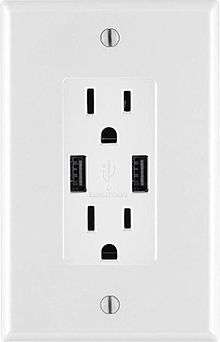
AC sockets of most types are now available with integrated USB power supplies. For some years these have only been offered with the legacy Type A connector, but as of 2017 sockets with USB-C and faster charging technologies have also been released.[100] These sockets are normally arranged so that they are the same size as the regular AC sockets of their type, but in addition have one or two USB sockets installed in parts of the faceplate which would otherwise be unoccupied. They are intended to provide a convenient solution for devices requiring DC power or charging via a USB connector, such as cell phones and tablet computers.
Adaptors
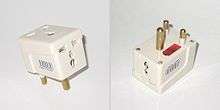
Adaptors allow travellers to use portable devices with foreign sockets. Adaptors allow physical connection between plug and socket but do not change voltage or frequency. A voltage converter is required for electrical compatibility in countries with a different voltage than the device is designed for, if it is not designed for variable voltage input.
Multisocket adaptors allow the connection of two or more plugs to a single socket. They are manufactured in various configurations, depending on the country and the region in which they are used, with various ratings. In Europe for example, they are called double or triple adaptors, and transform one socket into a multiple socket. This allows connecting more than one electrical consumer item to one single socket and is mainly used for low power devices (TV sets, table lamps, computers, etc.). They are usually rated at 6 A 250 V, 10 A 250 V, or 16 A 250 V, however this is the general rating of the adaptor (for example, if we have an adaptor for four sockets and it is marked 16 A 250 V, this means that the adaptor should not be loaded more than 16 A, whether one, two, three or all sockets are used. Some people overload them, thus leading to accidents). In some countries these adaptors are banned and are not available in shops, as they may lead to fires due to overloading them. Adaptors can be made with ceramic, Bakelite, or other plastic bodies.
Unusual types
Lampholder plug
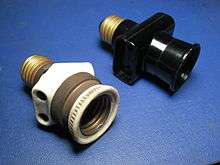
A lampholder plug fits into the bayonet cap or Edison screw socket of a lampholder in place of a light bulb and enables an electrical appliance to be powered from a wall or ceiling light fitting. As mentioned in Early History above, they were first introduced in the late 1800s and in use to the 1960s in situations where wall sockets were scarce and sometimes non-existent in some rooms (bathrooms, cellars, attics, etc.). Also, as in some countries (such as Italy) electricity was supplied on a "split tariff" basis with electricity for lighting being charged at a lower rate than that for other purposes, lampholder plugs enabled the consumers to reduce their electricity costs and were thus in broad use.
Lampholder plugs were and are rarely fused.
In the UK, lighting circuits are protected with a 5 A fuse or 6 A miniature circuit breaker.[101] Wiring regulations in the UK and some other countries no longer approve lampholder plugs because of the risks of overheating and fire.
Edison screw lampholder adaptors (for NEMA 1-15 plugs) are still easily found and commonly used in the Americas.
NEMA 2‐15 and 2‐20
These unearthed plugs with two flat parallel blades are intended for use on 240 volt circuits. The 2‐15 has coplanar current blades, and is used for 240 V service at 15 A, while the 2‐20 has the blades at 90° relative to each other (one vertical, one horizontal) and is used for 240 V service at 20 A. NEMA 2 plugs and sockets are rare because they are unearthed and so, no longer permitted for new installations. They have no neutral. In some cases these plugs can be inserted into incorrect-voltage sockets. Prior to the adoption of the NEMA standard, a plug nearly identical to the 2‐20 was used for 120 V at 20 A. That obsolete plug would fit into 5‐20 and 6‐20 sockets, which supply different voltages, but will not fit a NEMA 2‐20 socket.
Soviet adaptor plugs
Some appliances sold in the Soviet Union had a flat unearthed plug with an additional pass-through socket on the top, allowing a stacked arrangement of plugs. This design was very useful, because the usual Soviet apartment of the 1960s had very few sockets, but somewhat unsafe; the brass cylinders of the secondary socket were uncovered at the ends (to allow them to be unscrewed easily), recessed by only 3 mm, and provided bad contact because they relied on the secondary plug's bisected expanding pins. The pins of the secondary plug (which lacked insulation sleeves) could not be inserted into the cylindrical sockets completely, leaving a 5 mm gap between the primary and secondary plugs. The adaptors were mostly used for low power appliances (for example, connecting both a table lamp and a radio to a socket).
UK Walsall Gauge plug

Unlike the standard BS 1363 plugs found in the UK, the earth pin is on a horizontal axis and the line and neutral pins on a vertical axis. This style of plug/socket was used by university laboratories (from batteries) and the BBC, and is still in use on parts of the London Underground for 110 V AC voltage supply.[102] In the 1960s they were used for 240 V DC in the Power laboratory of the Electrical Engineering department of what was then University College, Cardiff. Power was supplied by the public 240 V DC mains which remained available in addition to the 240 V AC mains until circa 1969, and thereafter from in-house rectifiers. They were also used in the Ministry of Defence Main Building on circuits powered from the standby generators to stop staff from plugging in unauthorised devices, e.g. kettles. They were also known to be used in some British Rail offices for the same reason.
Italian BTicino brand Magic security connector



Centre: assortment of Magic Security sockets (in orange, the industrial three-phase type).
Right: assortment of Magic Security plugs.
This style of connector, produced by Italian manufacturer BTicino, appeared in the 1960s and was intended as an alternative to the Europlug or CEI 23-16 connectors then in use.[103] The socket is an almost rectangular socket, with one or more lateral key pins and indentations to prevent inverting the polarised plug, or connecting plugs and sockets with different current ratings. At least four models were produced: three single-phase general purpose connectors rated respectively 10 A, 16 A and 20 A; plus a three-phase industrial connector rated 10 A; all of them have different key-pin positioning so plugs and sockets cannot be mismatched.[104] The socket is closed by a safety lid (bearing the word ‘’Magic’’ on it) which can be opened only with an even pressure on its surface, thus preventing the insertion of objects (except the plug itself) inside the socket. The contacts are positioned on both sides of the plug; the plug is energized only when it is inserted fully into the socket.

The obvious drawback of the system is that it is not compatible with Italian 10 A and 16 A plugs, as well as with Europlugs. As household appliances were never sold fitted with these security plugs and the use of adaptors would defeat all of the newly introduced safety features, once this system is adopted all standard plugs must be cut off and replaced with the appropriate security connector. However, the Magic security system had some success at first because its enhanced safety features appealed to customers; standard connectors of the day were considered not safe enough.[103] The decline of the system occurred when safety lids similar to the Magic type were developed (Vimar Sicury[105]) and then applied to standard sockets by third brands and by BTicino itself.
In Italy, the system was never definitively abandoned and, though very rarely seen today, is still marked as available in BTicino’s products catalogue,[106] (except for the three-phase version, which stopped production in July 2011).
In Chile, 10 A Magic connectors are commonly used for computer/laboratory power networks, as well as for communications or data equipment. This allows delicate electronics equipment to be connected to an independent circuit breaker, usually including a surge protector or an uninterruptible power supply backup. The different style of plug makes it more difficult for office workers to connect computer equipment to a standard unprotected power line, or to overload the UPS by connecting other office appliances.
In Iceland, Magic plugs were widely used in homes and businesses alongside Europlug and Schuko installations. Their installation in new homes was still quite common even in the late 1980s.
Single phase electric stove plugs and sockets

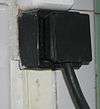
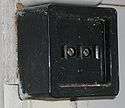
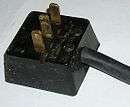
The plugs and sockets used to power electric stoves from a single-phase line have to be rated for greater current values than ones for three-phase system because all the power has to be transferred through a single line. Electric stoves are often hardwired to the electrical supply system, connected to the mains with an appropriate high power industrial connector or with non-standard high power proprietary domestic connector (as some countries do not have wiring regulations for single-phase electric stoves). In Russia an electric stove can often be seen connected with a 25 to 32 A connector.
In Norway and parts of Sweden a 25 A grounded connector, rectangular shaped with rounded corners, is used for single phase stoves. The connector has three rectangular pins in a row, with the grounding pin longer than other two. The corresponding socket is recessed to prevent shocks. The Norwegian standard is NEK 502:2005 – standard sheet X (socket) and sheet XI (plug). They are also known as the two pole and earth variants of CEE 7/10 (socket) and CEE 7/11 (plug).
Industrial and multiphase
Plug and socket systems intended for high current, high voltage or polyphase industrial equipment, as well as additional contacts and larger contacts, may also include features to improve the security and safety of use. For example, a high-power plug may include a locking ring or twist-lock feature to prevent accidental disconnection in use. A socket may include a mechanical interlock that prevents insertion or removal of a plug unless the local safety disconnecting switch is open. Plugs may include special measures to contain an arc generated during disconnection. Plugs used for equipment in wet locations (such as mines) may include small supervisory contacts that check the integrity of the earthing conductor.
See also
- AC adapter
- DC connector
- IEC 60320 appliance couplers, the connections at the other end of power cords.
- IEC 60309 high-power industrial and polyphase connectors
- Mains electricity
- Mains electricity by country lists voltage, frequency, and connector types for over 200 countries
- Plug load
- Polyphase system
- Stage pin connector
References
- ↑ Collins (2006), "Power Point", Essential English Dictionary (2nd ed.), The Free Dictionary
- ↑ NEMA connector standard and the National Electrical Code
- ↑ "Parliament of Western Australia, Hansard, Legislative Assembly, Thursday, the 29th November, 1973" (PDF). Parliament of Western Australia. p. 5673. Retrieved 21 December 2017.
... pieces of equipment which are connected by a plug to a general purpose outlet ...'
- ↑ Douglas, J. (2010). Building Surveys and Reports. Wiley. p. 254. ISBN 9781444391084. Retrieved 7 February 2016.
- ↑ Stein, B. (1997). Building Technology: Mechanical and Electrical Systems. Wiley. p. 723. ISBN 9780471593195. Retrieved 7 February 2016.
- ↑ Linsley, T. (2008). Advanced Electrical Installation Work. Taylor & Francis. ISBN 9781136444487. Retrieved 7 February 2016.
- ↑ Smart Guide Wiring: step-by-step projects, Fran J. Donegan, Creative Homeowner Press, 2004, p.74 (retrieved 2 February 2012 from Google Books)
- ↑ "IEC 60050 – International Electrotechnical Vocabulary – Details for IEV number 195-02-06: "neutral conductor"". electropedia.org. Retrieved 7 February 2016.
- ↑ "IEC 60050 – International Electrotechnical Vocabulary – Details for IEV number 195-02-08: "line conductor"". electropedia.org. Retrieved 7 February 2016.
- ↑ Williams, N.; Sargent, J.S. (2012). Electrical Inspection Manual, 2011 Edition. Jones & Bartlett Learning, LLC. p. 29. ISBN 9781449695538. Retrieved 7 February 2016.
- ↑ Scaddan, B. (2011). 17th Edition IEE Wiring Regulations: Explained and Illustrated. Newnes. p. 44. ISBN 9780080969176. Retrieved 7 February 2016.
- ↑ Tzimenakis, J.; Holland, D. (2000). Electrical Product Safety: A Step-by-step Guide to LVD Self-assessment. Newnes. p. 58. ISBN 9780750646048. Retrieved 7 February 2016.
- ↑ John Mellanby (1957). The History of Electric Wiring. London: Macdonald.
- ↑ "Hotel review: Hotel Jen Beijing". The Shutterwhale. Retrieved 6 July 2018.
- ↑ "Imperium Resort". tripadvisor. Retrieved 7 July 2018.
- ↑ "Holiday Inn Cikarang Jababeka". tripadvisor. Retrieved 7 July 2018.
- ↑ "karaksa hotel Osaka Shinsaibashi I". tripadvisor. Retrieved 7 July 2018.
- ↑ "Ibis Singapore on Bencoolen". tripadvisor. Retrieved 7 July 2018.
- ↑ "Review – 85 Sky Tower Hotel, Kaohsiung". Etraveller Times. Retrieved 7 July 2018.
- ↑ "Radisson Blu Cebu". PinasMuna. PinasMuna. Retrieved 6 July 2018.
- ↑ Alert noting non-compliant power strips
- ↑ Sri Lanka Sets National Standard for Plugs and Socket Outlets – Standardized on Type G; sale of non-compliant sockets is banned as of August, 2018, and buildings must re-wire by August, 2038.
- ↑ Notification Reference: A12/0135/13 (online report), Weekly overview report of RAPEX notifications Report 5 (Ref. 6 A12/0135/13), Brussels, Belgium: European Commission, 8 February 2013, retrieved 2017-12-06
- ↑ James S. Jennings. "Army Sustainment: The Three Most Common Electrical Safety Issues in Deployed Environments". Archived from the original on 2012-02-23.
- ↑ "Universal Sockets Are Unsafe". Interpower Corporation. Interpower. Retrieved 6 July 2018.
- 1 2 3 4 5 6 "Universal Mains Sockets – A Warning!". UniversalSocket.org.uk. Retrieved 19 September 2015.
- ↑ https://www.voltimum.co.uk/articles/universal-sockets-are-unsafe
- ↑ https://www.voltimum.co.uk/articles/universal-sockets-are-unsafe
- ↑ "Universal socket-outlets – friend or foe?" (PDF). SwitchedOn. United Kingdom: Electrical Safety Council (issue 29, Summer 2013): 14–15. 2013. Retrieved 2015-01-23.
- ↑ "Nemko Ltd Test Report No. : 44188" (PDF). Electrical Safety Council UK. 12 November 2012. Retrieved 19 September 2015.
- ↑ BS 1363-2:1995+A4:2012, cl. 13.9
- 1 2 "Guidelines on the application of Directive 2006/95/EC". p. 7. Retrieved 24 February 2015.
- ↑ "Fraudulant use of CE Marking". Retrieved 24 February 2015.
- ↑ "Universal AC Outlet • Setup Guide" (PDF). Anaheim, CA: Extron Electronics. November 2017. 68-1638-01 Rev. F. Retrieved 2018-05-21.
- ↑ Plugs and socket-outlets for household and similar purposes – Part 1: General requirements (PDF) (Technical report) (3.2 Consol. with am1&2 ed.). Geneva, Switzerland: International Electrotechnical Commission IEC. 14 February 2013. IEC 60884-1. Retrieved 2015-01-23.
- ↑ IEC 61558-2-5 includes the following definitions: (3.1.101) Shaver transformer: isolating transformer for fixed installation and with a limited output, designed to supply electric shavers, toothbrushes, and similar appliances rated 50 VA or less used in a bathroom. It supplies only one shaver, or the like, at a time and (3.1.102) Shaver supply unit: accessory embodying a shaver transformer or a power supply unit incorporating a shaver transformer, and one or more socket outlets allowing the use of only one plug at a time.
- ↑ "Power plug & outlet Type F".
- ↑ "United States of America".
- ↑ "Electricity in Japan".
- 1 2 3 4 World Plugs Retrieved on 2015-03-27.
- 1 2 The letter system first appeared in such guides in 1967 (Electric Current Abroad. United States Department of Commerce, 1967. Retrieved on 2013-12-14.) which designated types A 2-pin US, B (BS 546), and C (BS 1363). The 1984 edition (Electric Current Abroad. United States Department of Commerce, 1984. Retrieved on 2013-12-14.) uses the letters A to G in the same manner as they are used today, and the last revision of the print series was in 1998 ("Electric Current Abroad" (PDF). US Department of Commerce, International Trade Administration (retrieved 9 October 2015). 2002. ). The International Trade Administration of the US Department of Commerce now publishes a web version: Electric Current Worldwide, which differs slightly from the IEC list and from Wikipedia's list at Mains electricity by country.
- ↑ ftp://ftp.cencenelec.eu/CENELEC/TCs/61/PlugsSockets.pdf Plugs and socket types in each CENELEC country, Retrieved 15 February 2012.
- ↑ AS/NZS 3112:2004, Approval and test specification – Plugs and socket-outlets, Standards Australia and Standards New Zealand
- ↑ "Mains Plugs with Insulated Pins. Australian Standards AS/NZS3112:2000 & AS/NZS3112:2004 refer [sic]". Access Communications. 19 April 2007.
- 1 2 NBR 14136:2002 – Plugues e tomadas para uso doméstico e análogo – Padronização [Plugs and socket-outlets for household use and similar purposes – Specification] (in Portuguese), BR: ABNT, 2002
- ↑ "Norma ABNT NBR 14136:2002" (in Portuguese). BR: Projeto de redes.
- ↑ "Archived copy". Archived from the original on 5 March 2016. Retrieved 2015-12-01. 9) Aquele fiozinho que tem pendurado atrás da minha geladeira, vai desaparecer?
- ↑ "World Plugs". International Electrotechnical Commission (IEC). Retrieved 27 August 2014.
- ↑ BS 1363 (1995), BS 1363:1995 "13 A plugs, socket-outlets, adaptors and connection units", British Standards Institute.
- ↑ BS 4573 (1970), British Standard Specification for two-pin reversible plugs and shaver socket-outlets, British Standards Institution.
- ↑ BS EN 61558-2-5:2010 Safety of transformers, reactors, power supply units and combinations thereof. Particular requirements and tests for transformer for shavers, power supply units for shavers and shaver supply units
- ↑ "IECEE CEE-7 ed2.0". Retrieved 1 March 2015.
- ↑ "IEC/TR 60083: Technical Report" (PDF). Retrieved 2 March 2015.
- ↑ ГОСТ 7396.1-89 (PDF) (in Russian), RU: Elec
- ↑ "Korea Power Adapter".
- ↑ "Det nye afsnit 6C i stærkstrømsbekendtgørelsen træder i kraft pr. 15. november 2011". Danish Safety Technology Authority (in Danish). Retrieved 19 September 2015.
- ↑ "International electrical standards and regulations" (PDF). Legrand. pp. 14, 22, 30. Retrieved 16 November 2015.
- ↑ Typical example of BS 4573 compliant socket that accepts europlug (and Australian) http://www.tlc-direct.co.uk/Technical/DataSheets/MK/K700.pdf
- ↑ "The Plugs and Sockets etc. (Safety) Regulations 1994". The Plugs and Sockets etc. (Safety) Regulations 1994. Opsi.gov.uk. 1994. Retrieved 16 November 2015.
- ↑ "Plug Type K".
- ↑ 5. udgave af Stærkstrømsbekendtgørelsen afsnit 107-2-D1 "Stikpropper og stikkontakter for danske systemer" (in Danish), DK: Sik, archived from the original on 7 December 2008
- ↑ BEK nr 1041 af 10/11/2011: Bekendtgørelse om stærkstrømsbekendtgørelsen, afsnit 6C, særlige krav til anvendelse af stikpropper og stikkontakter i installationer (in Danish), DK: Retsinformation
- ↑ "Italy Power Plug".
- ↑ De Cesco 1975, pp. 70–71.
- ↑ De Cesco 1975, pp. 56–57.
- ↑ De Cesco 1975, p. 93.
- ↑ "Bestreben Nach Sicherheit | Vimar". Vimar.de. Retrieved 12 March 2013.
- ↑ La ricerca della sicurezza. Ma la ricerca continua (in Italian), Vimar, retrieved 22 January 2009
- 1 2 "Plug Type J" (official site). Geneva, Switzerland: International Electrotechnichal Commission IEC. Retrieved 2017-05-26.
Type C plugs are perfectly compatible with Type J sockets.
- ↑ "SEV 1011:2009, Plugs and socket-outlets for household and similar purposes" (PDF) (official site). Fehraltorf, Switzerland: Electrosuisse, SEV Verband für Elektro-, Energie- und Informationstechnik. 2009. Retrieved 2017-05-26.
- 1 2 3 "Information SEV 1011 – power socket/plug/connector" (PDF) (official site). Fehraltorf, Switzerland: Federal Inspectorate for Heavy Current Installations ESTI, Swiss Confederation. 1 August 2011. Retrieved 2017-05-26.
- ↑ "Einsatzende der Steckdosen Typ 12" (PDF) (official journal). Bulletin Electrosuisse/VSE (in German, French, and Italian). 2016 (8). Fehraltorf, Switzerland: Federal Inspectorate for Heavy Current Installations ESTI, Swiss Confederation. 2016. Retrieved 2017-05-26.
- ↑ "Partially insulated Swiss plugs for increased safety" (PDF) (official site). Fehraltorf, Switzerland: Federal Inspectorate for Heavy Current Installations ESTI, Swiss Confederation. 7 March 2011. Retrieved 2017-05-26.
- ↑ "SEV 1011:2009/A1:2012, Plugs and socket-outlets for houshold [sic] and similar purposes – A1: Multiway and intermediate adaptors, cord sets, cord extension sets, travel adaptors and fixed adaptors" (PDF). Fehraltorf, Switzerland: Electrosuisse, SEV Verband für Elektro-, Energie- und Informationstechnik. 2012. Retrieved 2017-05-26.
- ↑ Dario Marti, Director (March 2013). "Plugs and socket-outlets for household use and related purposes: New product requirements for the Swiss market" (PDF) (official site). Fehraltorf, Switzerland: Federal Inspectorate for Heavy Current Installations ESTI, Swiss Confederation. Retrieved 2017-05-26.
- ↑ "International standardization of electrical plugs and socket-outlets for domestic use". CH: IEC. Retrieved 20 May 2017.
- ↑ "When Less is More..." ZA: Crabtree. Archived from the original on 6 July 2010.
- ↑ "SANS 164 standards: a working group perspective" (PDF). ZA: EE publishers. Archived from the original (PDF) on 20 March 2012.
- ↑ National Standard of the People's Republic of China GB 1002-2008, Single phase plugs and socket-outlets for household and similar purposes – Types, basic parameters and dimensions (PDF), PRC: General Administration of Quality Supervision, Inspection and Quarantine of the People's Republic of China (AQSIQ), 2008, Archived from the original on 4 August 2016
- 1 2 "SI 32 standard Israeli plugs and sockets". PlugSocketMuseum.nl. Retrieved 8 June 2018.
- ↑ "SI 32 part 1.1, draft, 3/2013. Figure #203" (PDF). The Standards Institution of Israel (in Hebrew). p. 14. Archived from the original (PDF) on 6 November 2014. Retrieved 19 September 2015.
- ↑ US patent 1064833, Harvey Hubbell, "Separable Atttachment Plug", issued 17 June 1913
- ↑ US patent 1180648, Harvey Hubbell, "Attachment Plug", issued 25 April 1916
- ↑ WD6, Dimensional requirements for plugs and receptacles (standard), NEMA
- ↑ "NECA 130-2010, Standard for Installing and Maintaining Wiring Devices". National Electrical Contractors Association.
- ↑ Tamper-Resistant Receptacles – A Successful Adoption (PDF), archived from the original (PDF) on 2 December 2013, retrieved 19 November 2013
- ↑ Child outlet safety, archived from the original on 22 January 2009, retrieved 21 January 2009
- ↑ Drew Campbell Technical Film and Tv for Nontechnical People, Skyhorse Publishing Inc., 2002 ISBN 1581159986 Chapter 9
- 1 2 JIS C 8303-1993, Plugs and Receptacles for Domestic and Similar General Use, Japanese Standards Association, 1993
- ↑ "Electricity in Japan". japan-guide.com. 2015. Retrieved 19 September 2015.
- ↑ Alice Gordenker (19 July 2011). "Japan's incompatible power grids". The Japan Times. Retrieved 3 September 2015.
- ↑ "内線規程 改訂のポイントの解説ページ". Archived from the original on 24 January 2012.
- ↑ "TIS 166-2549 (2006) (English): Plugs and socket-outlets for household and similar purposes : plugs and socket-outlets with rated voltage not exceeding 250 V" (PDF). Archived from the original (PDF) on 7 July 2016.
- ↑ Thai Industrial Standard 166-2547: Plugs and socket-outlets for household and similar purposes: plugs and socket-outlets with rated voltage not exceeding 250 V (PDF) (in Thai). TH: Thai Industrial Standards Institute. ISBN 974-9815-94-7. Archived from the original (PDF) on 26 April 2012. Retrieved 23 November 2011.
- ↑ "Power plug & outlet Type O". WorldStandards.eu. 31 October 2017. Retrieved 29 May 2018.
- ↑ "OREI Thailand Travel Plug Adapter – 2 USA Inputs – 3 Pack – Type O". BombayElectronics.com. Retrieved 29 May 2018.
- ↑ "Check your need for a travel adapter!". Power-Plugs-Sockets.com. Retrieved 2 June 2018.
- ↑ "Thai – Power Cords". InternationalConfigurations.com. Retrieved 2 June 2018.
- ↑ "Every International Outlet, in One Handy Chart". GearPatrol.com. 6 February 2015. Retrieved 2 June 2018.
- ↑ Quick Charge USB-C power outlets rocket your home into the future – BGR.com
- ↑ "Miniature Circuit Breakers" (PDF). UK: MK Electric. p. 4. Retrieved 22 April 2010.
- ↑ "Non-standard BS 1363 types". Museum of Plugs and Sockets. Retrieved 19 September 2015.
- 1 2 De Cesco 1975, p. 73.
- ↑ De Cesco 1975, p. 75.
- ↑ "La ricerca della sicurezza. Il brevetto Sicury". www.vimar.eu. Retrieved 12 February 2009.
- ↑ "Il Classico Dell'Installazione Civile" (PDF). bticino.assetbank-server.com. Retrieved 20 May 2017.
Bibliography
- De Cesco, Giancarlo (1975). Acqua Luce Gas. Manuali pratici del far da sé [Plumbing Electricity Gas. Practical Do-it-yourself Handbooks]. I Jolly bricolage. (in Italian). Milan: Fratelli Fabbri Editori.
External links
| Wikimedia Commons has media related to Mains connectors. |
| Wikibooks has a book on the topic of: Guide to electrical equipment for travellers |
- Digital Museum of Plugs and Sockets (comprehensive collection of plugs and sockets)
- Glossary of standards terms